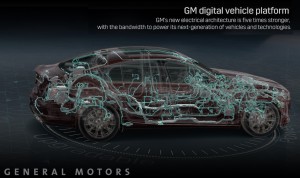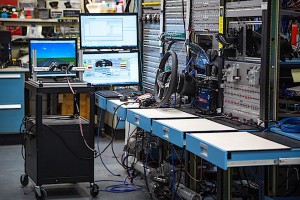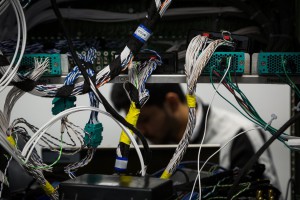
GM's new digital vehicle platform can process 4.5 terabytes per hour and will debut on the 2020 Cadillac CT5 sedan.
General Motors is pushing to remain a leader in autonomous technology with new vehicles and mobility services; however, it’s latest development may be the most critical to ensure it remains at the front of the pack.
The company unveiled its new all-new digital platform architecture, designed with the needs of future, such as connected cars, autonomous electric vehicles and other technologies, in mind. Until now, GM has been loading up its previous gen architecture with new tech, despite the fact it is more than 20 years old and comes with limitations.
The new architecture, which will underpin the 2020 Cadillac CT5 sedan and its Super Cruise semi-autonomous driving feature, should be available across nearly all GM product lines by 2023, the company says.
GM vehicles will continue to evolve in the next five to 10 years, and in the process, require more electrical bandwidth and connectivity to ensure that features like electric propulsion systems, the Super Cruise driver assistance feature and advanced active safety systems can all run in conjunction with each other.
(GM’s Cruise unit gets additional $1.15 billion in funding. Click Here for the story.)
“It’s the brain and nervous system of the vehicles, and it’s five times more capable than the one fitted to current vehicles,” said Al Adams, GM’s director of electric architecture and technology, told ArsTechnica.
The new platform can manage processing up to 4.5 terabytes per hour. It supports much higher bandwidth, which means component connections of 100Mb/s, 1Gb/s, and 10Gb/s, which can be used advanced driver assistance systems in future GM vehicles.
“The critical role of software and its importance to our vehicles, both now and for years to come, cannot be overstated,” said GM President Mark Reuss in a statement. “Our new digital vehicle platform and its eventual successors will underpin all our future innovations across a wide range of technological advancements, including EVs and expanded automated driving.”
(Click Here to see more about GM updating the look of the 2020 Chevy Camaro.)
Cybersecurity is another key pillar of the new architecture, GM notes. The system’s DNA includes additional protective features at the hardware and software levels that reflect the company’s foresight in this regard.

GM's Electrical Integration Lab in Warren, Michigan, played a pivotal role in the development of GM's digital vehicle platform.
GM was among the first automakers to create an integrated and dedicated global Product Cybersecurity organization, a team of experts within the company focused on protecting against the potential risk of unauthorized access to vehicles and customer data, the company says.
The higher level of security also means greater comfort in receiving over-the-air software updates that Tesla has shown to be crucial to providing value to vehicle owners.
(To see more about GM investing $1 billion into its Missouri plant, Click Here.)
“Almost all the modules on the system have the ability to be OTA updated,” Adams said in the ArsTechnica report. “The interface is much like a smartphone and enables us to change the vehicle’s character.”

